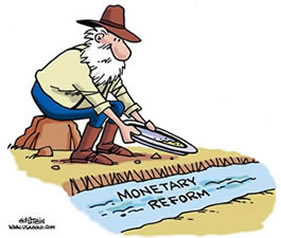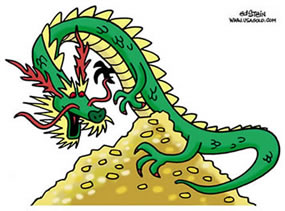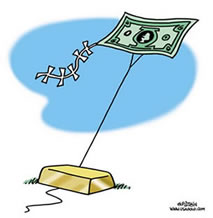The Most Important Gold Market Event Since 1999
Commodities / Gold and Silver 2012 Jun 02, 2012 - 01:56 PM GMT Consider this from a recent World Gold Council (WGC )report:
Consider this from a recent World Gold Council (WGC )report:
"Central banks continued to buy gold; net purchases recorded during the [first quarter, 2012] amounted to 80.8 tonnes, accounting for around 7% of global gold demand. Central banks from a diverse group of countries added to the overall holdings of the official sector, with a number of banks making sizable purchases. Diversification requirements and growth in foreign exchange reserves of a number of countries point towards a continuation of this trend."
 In keeping with this analysis, the World Gold Council moved to "incorporate official sector purchases as an element of gold demand" (my emphasis) in its fundamentals table. Previously central banks occupied a slot on the supply side of the ledger. "The net purchasing of gold by the official sector," says the Council, "is now an established trend, which is likely to remain in place for the forseeable future." More than just a symbolic change, the World Gold Council's alteration documents an important shift in gold market dynamics. In 2002, central banks contributed 545 tonnes of gold to the supply. Ten years later, in 2011, they purchased 440 tonnes -- a significant nearly 1000 tonne swing on the fundamentals table. Just as significantly, "signatories to the third Central Bank Gold Agreement," says WGC, "have almost ceased sales of their gold."
In keeping with this analysis, the World Gold Council moved to "incorporate official sector purchases as an element of gold demand" (my emphasis) in its fundamentals table. Previously central banks occupied a slot on the supply side of the ledger. "The net purchasing of gold by the official sector," says the Council, "is now an established trend, which is likely to remain in place for the forseeable future." More than just a symbolic change, the World Gold Council's alteration documents an important shift in gold market dynamics. In 2002, central banks contributed 545 tonnes of gold to the supply. Ten years later, in 2011, they purchased 440 tonnes -- a significant nearly 1000 tonne swing on the fundamentals table. Just as significantly, "signatories to the third Central Bank Gold Agreement," says WGC, "have almost ceased sales of their gold."
Quite unexpectedly, except perhaps among a handful of long-time gold advocates, gold is quietly and gradually moving back to its centerpiece role in international reserves. Stretched and threatened financially, nation states have begun accumulating gold for the same reason private individuals do -- as portfolio insurance to cover a wide assortment of economic uncertainties. What's more, this restoration has not occurred formally as a result of an international agreement as was so often the case in the past, but informally as a natural evolution in the way nation states think about and react to the long-term value of currency reserves. As such, it suits the times and suggests an authenticity that is likely to transform the gold market at its core. In my view, this swing in the supply-demand fundamentals will come to be recognized in future years as the most important gold market event since the Central Bank Gold Agreement (CBGA) of 1999 -- the accord that many believe kicked-off the secular gold bull market. (The CBGA capped the sales and leasing of gold by its signatories, the most active central banks in the gold market at the time.)
The Asia gold call
In gold producing countries like China (the largest producer) and Russia (the fifth largest) most, if not all, domestic production is being converted directly to reserves. Other central banks, like India, Mexico, Turkey, the Philippines and a growing list of others (including some who probably would just as soon like to keep it quiet) are buying gold on the open market when it becomes available. One has dramatically reduced supply; the other has dramatically increased demand.
If you would like to broaden your view of gold market, we invite you to sign-up for our regular newsletter and receive quality commentary like what you are now reading. It's free of charge and comes by e-mail. You can opt out at any time.
It took almost four years for the CBGA to affect prices, and it may take that long for the full impact of the new shift in central bank activity to render its effect on the current market. However, times have changed, and we could be on a shorter fuse. Even now, there are rumors circulating the market of Asian central bank purchases on any drop into the $1500 to $1550 range -- a gold call of sorts that puts a floor under the price.
Dan Norcini, the well-known gold market analyst who plies his trade at Jim Sinclair's Mineset website, makes the following observation:
"Every time we've gone down below $1,550 and dipped into this support level, we've had very strong, quality buying emerge. Most of the time this type of buying is associated with central bank purchases, particularly central bank buying coming out of the East. The bottom line is there was some very powerful buying that came into the gold market from some extremely strong hands. They were strong enough that they could absorb hedge fund algorithm related selling, which is significant right now across the commodity sector."
 It is precisely because of the lack of readily available physical gold in size that China and Russian have chosen to take the route of increasing their reserves through domestic production -- a strategy, by the way, from which the United States could benefit. The U.S. at present houses the largest gold reserve in the world at over 8000 tonnes and hosts the world's third largest mine production at 243 tonnes. It could begin increasing its own reserves by simply offering to purchase domestic production on a right of first refusal basis at market prices.* In addition to China purchasing its own production, there have been consistent reports of its interest in buying gold directly from foreign mining companies, particularly in Australia and Africa. As the restoration process proceeds, the price over time is likely to move progressively higher extending the length of gold's bull market beyond anything most observers have thus far contemplated, while at the same time enhancing the metal's status as a reserve asset.
It is precisely because of the lack of readily available physical gold in size that China and Russian have chosen to take the route of increasing their reserves through domestic production -- a strategy, by the way, from which the United States could benefit. The U.S. at present houses the largest gold reserve in the world at over 8000 tonnes and hosts the world's third largest mine production at 243 tonnes. It could begin increasing its own reserves by simply offering to purchase domestic production on a right of first refusal basis at market prices.* In addition to China purchasing its own production, there have been consistent reports of its interest in buying gold directly from foreign mining companies, particularly in Australia and Africa. As the restoration process proceeds, the price over time is likely to move progressively higher extending the length of gold's bull market beyond anything most observers have thus far contemplated, while at the same time enhancing the metal's status as a reserve asset.
* Strongly positioned mining companies with proven reserves and management that fully understands the evolving role of gold in national reserves would be obvious beneficiaries under the circumstances described. At the same time, mining companies should not be owned to the exclusion of the metal itself. It should be kept in mind that mining stocks are stocks first and a form of gold ownership second. Gold coins and bullion are wealth insurance first and an investment second. The first objective should be to secure one's portfolio. The second should be avenues for potential profit.
Postscript The vision of Nobel Prize laureate, Robert Mundell
 I do not believe that some version of the gold standard is necessarily the best or only approach to restoring gold's place in the monetary system. Simply using gold as a reserve asset as Nobel prize-winning economist Robert Mundell suggested many years ago could go a long way in restoring confidence in the various currencies. Secondly, it would give the central banks some protection against beggar-thy-neighbor currency policies that tend to undermine the value of currency reserves. In other words, it would serve as a hedge. This is precisely what Mundell envisioned when he recommended that Europe use gold as a core reserve in establishing the euro.
I do not believe that some version of the gold standard is necessarily the best or only approach to restoring gold's place in the monetary system. Simply using gold as a reserve asset as Nobel prize-winning economist Robert Mundell suggested many years ago could go a long way in restoring confidence in the various currencies. Secondly, it would give the central banks some protection against beggar-thy-neighbor currency policies that tend to undermine the value of currency reserves. In other words, it would serve as a hedge. This is precisely what Mundell envisioned when he recommended that Europe use gold as a core reserve in establishing the euro.
Robert Mundell from a lecture delivered at St. Vincent College, Latrobe, Pennsylvania (1997):
"I do not think that we will see the time when either of those two great economic powers, the United States and the European Union, will ever again fix their respective currencies to gold as they have in the past. More likely, gold will be used at some point, maybe in 10 or 15 years when it has been banalized among central bankers, and they are not so timid to speak about its use as an asset that can circulate between central banks. Not necessarily at a fixed price, but a market price. . .Gold is going to be a part of the structure of the international monetary system for the 21st century, but not in the way it has been in the past. We can look upon the period of the gold standard, the free coinage gold standard, as being a period that was unique in history, when there was a balance among the powers and no single superpower dominated."
Fifteen years later, as Mundell predicted, gold is being bandied about as an important component in the monetary system of the future. Ben Steill of the Council on Foreign Relations, World Bank president, Robert Zoelick, former Kansas City Federal Reserve president Thomas Hoenig and former Fed Chairman Alan Greenspan -- all have spoken favorably of gold's restoration as a component of central bank reserves. In a recent essay on a formal gold revaluation, Quaintance and Brodsky offer a strategy worth contemplating: "We suggest one keep identities straight; invest with central banks, not against them; and consider the hollow rhetoric of the establishment that may temporarily suppress its paper price 'a gift.' They are working for physical gold holders, not against them."
For a free subscription to our newsletters, please click here.
By Michael J. Kosares
Michael J. Kosares , founder and president
USAGOLD - Centennial Precious Metals, Denver
Michael Kosares has over 30 years experience in the gold business, and is the author of The ABCs of Gold Investing: How to Protect and Build Your Wealth with Gold, and numerous magazine and internet articles and essays. He is frequently interviewed in the financial press and is well-known for his on-going commentary on the gold market and its economic, political and financial underpinnings.
Disclaimer: Opinions expressed in commentary e do not constitute an offer to buy or sell, or the solicitation of an offer to buy or sell any precious metals product, nor should they be viewed in any way as investment advice or advice to buy, sell or hold. Centennial Precious Metals, Inc. recommends the purchase of physical precious metals for asset preservation purposes, not speculation. Utilization of these opinions for speculative purposes is neither suggested nor advised. Commentary is strictly for educational purposes, and as such USAGOLD - Centennial Precious Metals does not warrant or guarantee the accuracy, timeliness or completeness of the information found here.
Michael J. Kosares Archive |
© 2005-2022 http://www.MarketOracle.co.uk - The Market Oracle is a FREE Daily Financial Markets Analysis & Forecasting online publication.



